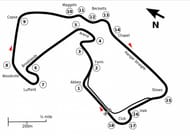The British Grand Prix will get underway this weekend at Silverstone, with the first practice session due to be held tomorrow evening. We bring you a 5-point introduction to the track:
-
It’s one of the oldest tracks on the circuit
Silverstone as a circuit has been around since before the Second World War. The track first hosted the British Grand Prix 67 years ago, in 1948. The home of the British Grand Prix changed several times over the course of Formula One history, from Silverstone to Aintree, in Liverpool, and Brands Hatch, in the English county of Kent. Brands Hatch hosted 12 Grands Prix and still hosts many international racing events to this day, with German racing legend Gerhard Berger once describing it as the “best track in the world”. Silverstone has been the permanent home of the British Grand Prix since 1987.
-
It is the second-longest track on the circuit
Silverstone is 3.66miles, or about 5.9km long, and is one of the longest tracks. The only track on the current motor-racing calendar longer than it is Spa-Francorchamps, which hosts the Belgian Grand Prix, which will be held this August.
3. It lies on a World War II air force base
The base, used by the Royal Air Force during the war, was called RAF Silverstone, and lay across the English counties of Northamptonshire and Buckinghamshire. Three runways made for the use of the air force intersect in the form of a triangle and are still there to this day, although they are now contained inside the track, which outlines it.
-
It was redesigned in the 1990s
Silverstone is known to be a fast-paced, overtake-friendly circuit, but following several fatal crashes in the early 90s, most notably those of F1 legend Ayrton Senna and Roland Ratzenberger, who died the day before Senna at the San Marino Grand Prix, Formula One officials called for the remodeling and redesign of several circuits with a view to increasing safety.
Several kinks and high speed turns at Silverstone, most notably Abbey – which was a kink, modified to a chicane, or a double bend instead to make it less dangerous.
-
Watch out for Maggotts!
No, there are no creepy-crawlies at the track! Maggotts is one of Silverstone’s highest-speed corners – reigning World Champion Lewis Hamilton admits that the g-force on drivers at Maggots and its following turn, Becketts, is unmatched.
The two turns are part of a complex trio – Maggotts, Becketts and Chapel. The complex involves three left-right turns in immediate succession, which need to be executed at a minimum of 130 miles per hour.




